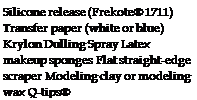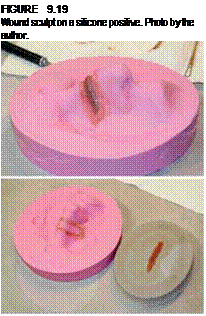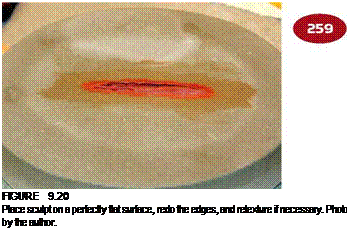The following is not exactly Christien Tinsley’s recipe; Christien’s a great guy, but he’s not going to give away the proprietary formula and process for an innovation that won him a 2007 Scientific and Technical Academy Award. But it is one that works; Oscar nominee Vittorio Sodano used it for the 2006 Mel Gibson epic Apocalypto and he shared it with me.
You can try your own, too. The technical and creative proclivity of this industry only advances by curious experimentation and discovery, so go experiment and discover.

![]()
Silicone mold rubber Silicone parchment paper.002 mm acetate sheets Small (dental) spatula Pre-colored bondo Scissors
Final Seal or Blue Aqua Sealer
Remember that bondo is a mixture of Pros-Aide® and Cab-O-Sil®; you can color it with a bit of flocking material, pigment, or both—it depends largely on what the end result is supposed to be. With pigment, the appliance may become opaque, but with flocking, there will be translucency and visible variation in the surface coloration.
1. Once the lifecast has been made of the body part needed for the 3D transfer, cast a silicone positive because this is what you will sculpt the prosthetic on.
For silicones, the higher the Shore A number, the harder the cured silicone. For example, Smooth-On’s Dragon Skin® has a Shore A hardness of 10, which is pretty soft. Polytek’s Plat-Sil Gel 10 has a Shore A hardness of —you guessed it—10; also soft, which is why it’s good for prosthetic appliances, but not for this. Smooth-On’s Mold Max 30 has a Shore A hardness of 30, which is fairly stiff and should be sufficient for this process.
2. Sculpt the appliance with either modeling clay (such as Chavant® Le Beau Touche) or modeling wax.


When you’re done with the sculpture, put the silicone positive in the freezer until the piece freezes.
3. Carefully remove the clay piece (or pieces) from the silicone positive; the silicone will still be pliable even if the clay is very firm from being frozen. Press against the silicone to help separate it from the clay, being careful not to disturb the edges more than necessary.
4. Lay the clay onto an 8% x 11-inch sheet of silicone parchment paper (a larger sheet if necessary). Gently press it down with a soft sponge until the clay bottom is in complete contact with the parchment, especially the edges. Make sure you are doing this on a completely flat surface.
5. Retexture if necessary.
6. Build a clay flashing channel and a low retaining wall; you’re creating a box mold. Use foam-core strips or flexible rubber molding, depending on the shape you need for the new mold, and hot-glue the wall (low temp so you don’t melt the acetate) so that it won’t leak.
7. Mix enough Hard Shore A silicone to rise % inch (1 cm) above the highest point of the clay. When the silicone has fully cured, peel the clay out of the mold and clean any residue with 99 percent IPA and a Q-tip®.
8. Release the negative mold with silicone release—Mann’s Ease 200 or Ease 800,
Loctite’s Frekote® 1711, or Smooth-On’s Universal Mold Release will each work— and then add the precolored bondo, making sure to get into every part of the mold.
9. Cut and place a piece of the silicone parchment paper across the top of the negative
TIP
You can follow the instructions here, or you can sculpt your piece directly on a smooth surface that you can then make a silicone mold of, complete with flashing channel. simply begin at step 6 instead of step 1. Personally, i prefer to sculpt the appliance on a smooth, flat surface.
![]()
mold. Make sure the flat scraper is wider than the mold and then use it to squeegee the excess bondo into the flashing channel, taking care not to press hard enough to remove any material from the negative itself.
10. Now place this mold in the freezer until the bondo is frozen and then carefully peel out the prosthetic and the silicone parchment paper from the mold.
TIP
if you use the silicone parchment,
you will notice that moisture from the bondo will
cause the paper to buckle somewhat. Don’t worry, this will not
affect the application of the piece. You might want to try using the
.002 mm acetate in place of the parchment; it will not buckle and you will
get a perfectly uniform contact with the bondo. However, you must properly
release the acetate before using it or you will never get it off the appliance
when you attach the transfer paper. A thin layer of Frekote® 1711 applied
first, followed by a thin layer of Krylon Dulling Spray, will allow the
acetate sheet to easily peel away from the appliance after
you’ve attached it to the transfer paper.

This is what has happened to the bondo: When the adhesive freezes, it becomes polymerized (becomes plastic) but remains soft and rubbery and still a bit tacky. Why? Near as I can figure it, it’s because Pros-Aide® is a water-based acrylic adhesive; when it freezes, the water is drawn out of the acrylic, allowing it to plasticize and become rubbery. When it thaws, the water begins to evaporate, leaving just the plasticized bondo. I’m not a chemist and haven’t asked one about this because it’s only occurring to me now as I’m writing it.
11. Allow the prosthetic to dry. You might want to hit it with a hair dryer for a few minutes to help it along. It could take as long as an hour or more to dry if allowed to just sit. It is partly dependent on the size of the appliance.
12. Powder the appliance to remove the tackiness and store it safely covered until you’re ready to use it.
13. When you are ready to use it, stipple a light coat of Pros-Aide® over the surface of the prosthetic transfer all the way to the edges using a small piece of latex makeup sponge or a Q-tip® and let the adhesive dry until it’s clear.
14. Place the prosthetic face-down onto the shiny side of the transfer paper.
15. Press the appliance firmly onto the transfer paper, paying close attention to the edges. This is the most important part of the process.
16. Trim the paper as close to the edge of the prosthetic as you can.
![]()
17. Slowly peel off the silicone parchment (or acetate). If any part of the prosthetic starts to pull away from the transfer paper, carefully press the whole appliance back onto the paper and repeat until the silicone parchment or acetate comes away cleanly.
Now the transfer is ready for application.
18. Make sure the skin is clean, dry, and oil/makeup-free.
19. Carefully position and place the appliance face down onto the skin and press firmly.
20. Wet the back of the prosthetic—the transfer paper—with a moist paper towel, powder puff, cotton pad, or the like and hold it firmly to the paper for about 30 seconds.
21. Peel or slide the paper carefully off the prosthetic. Smooth the transfer with a bit of water and let it dry. Again, you can use a hair dryer to help. Any visible edges can be blended off easily with a small brush and 99 percent IPA.
22. Seal with Pros-Aide® (dry it first, then powder) or powder with translucent setting powder and then seal with Final Seal or Blue Aqua Sealer. Tinsley recommends Final Seal from Ben Nye®. FYI, Blue Aqua Sealer from Reel Creations is water-based acrylic and Final Seal is alcohol based.
Then apply makeup or paint as necessary. Matthew Mungle also uses bondo appliances for his award-winning makeup work, but foregoes the transfer paper route. His process is:
1. Two coats W. M. Creations Soft Sealer in a silicone mold.
2. Pros-Aide® Bondo spatulated into the mold. Dried.
3. One coat of Soft Sealer.
Take some time and try these and variations. Always remember: There is never one and only one way to do anything in our field. Removing bondo appliances is easy using Super Solv®, Bond Off!®, or Isopropyl Myristate, dampened on a powder puff, and so on.
